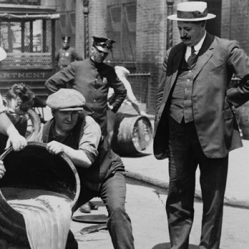Prohibition
A fascinating Ken Burns series about the noble experiment.

Photograph courtesy Library of Congress, Prints and Photographs Division.
What should a PBS viewer pour himself to enhance his enjoyment of Prohibition (PBS, Sunday through Tuesday at 8 p.m. ET)? In posing the question, I don't mean to suggest that this documentary, directed by Ken Burns and Lynn Novick, needs any help to go down easy. But it seems correct to celebrate the freedom to get one's buzz on. The freedom is, of course, vastly more important than the buzz itself, as Prohibition notes in its closing words. Here, the writer Pete Hamill, one talking head among a distinguished roster, says that he has hasn't had a drink in three decades. But, hypothetically, he'd be proud to touch the stuff again in a public protest against any legislative attempt to deny his fellow citizens that right.
So what to pour? Whiskey—the excessive consumption of which, in the 1800s, provided an early impetus for temperance organization—is a fine choice. You could also mix up a cocktail called the scofflaw. In a nifty aside, the documentary mentions that the word was coined to denote the very common criminals who kept boozing after the Last Night. Watery domestic beer would also work; passage of the 18th Amendment became possible partly because of the World War I-era vilification of German-Americans, some of whom had names like Pabst and Schlitz and Anheuser and Busch. Want to concoct something in your bathtub? Terrific. The notes of Soft Scrub in the bouquet will impart historically accurate odors.
Over three nights and five and half hours, Prohibition provides a very fine analytic survey of the noble experiment, and most criticisms of it are quibbles. However, if you are the type of viewer who, after The Civil War and Baseball, gets ticked off by certain Burnsian tics of style, then consider yourself warned. I mean, when the film recounts the moment that Carrie Nation received a message from God to vandalize saloons, a reading of her words plays over an image of yellow sunlight gracing a rural cobweb. There are a couple of corny re-creations of phone calls placed by the blockbuster bootlegger Roy Olmstead to his accomplices. But these seem a small price to pay for the delights of the series' archival footage and sturdy exposition—and for the sozzled trumpet that rings in the ridiculous era stretching from 1920 to 1933.
The first installment, titled “A Nation of Drunkards,” proves the most compelling, not least because alcohol and its American foes runs in a clear, easily traceable line. An early segment speeds through the back story of American drinking—the booze in the hold of the Mayflower, the daily ration of rum at Valley Forge, John Adams' hard-cider eye-openers. Then we're on to the religious revival of the Second Great Awakening and then evangelists of the Washington Society, a confederacy of reformed drunkards. Early campaigns for personal responsibility gave way to anti-saloon movements and to calls for enforced abstinence. The documentary quotes an anonymous clergyman condemning the last of these: "Very little good has ever been done by the absolute shall." A sound insight into human nature. Also, an idea for a liquor brand: Absolut Shall, the vodka for connoisseurs of auxiliary verbs.
Soon, Susan B. Anthony and Elizabeth Cady Stanton were addressing the problem of epidemic overindulgence. At a time when any number of men would come home wasted and beat their powerless wives, agitation against horrible potomania was largely a distaff cause, and a running thread of Prohibition tracks the shifting status of women. On the one hand, the Women's Christian Temperance Union and its ilk scapegoated alcohol as the cause of all suffering and the root of all social failures. On the other, they represented an important step in the organization of suffragettes and social reformers.
Thank heavens they paved the way for Pauline Sabin, who founded the Women's Organization for National Prohibition Reform to campaign against what Winston Churchill termed "an affront to the whole history of mankind." Sabin began her effort in 1929, by which time speakeasies had accomplished the coeducation of the school of bar-going. And Prohibition also contributes a frisky footnote, either somewhat dubious or totally interesting, to the philosophy of flappers: Discussing the fast pace of the Jazz Age and changes in gender relations, the FDR historian William Leuchtenburg proposes that "what happened in the 1920s is that men discovered the clitoris." Apparently, no one had ever before thought to check to the north.
Despite addressing what may seem a narrow topic, the documentary succeeds at presenting a broad consideration of America. A study in politics—in lobbying legislators, manipulating media, and exploiting wedge issues—is married to a social history of socializing. For instance, Prohibition explores the background of the saloon as a "working class private club" and the booze as an agent of political organizing. By the end—after the period has proved to be a "finishing school ... for organized crime syndicates," after we have tearfully watched federal agents smash barrels of whiskey—Burns' trumpet is at once weary and celebratory.